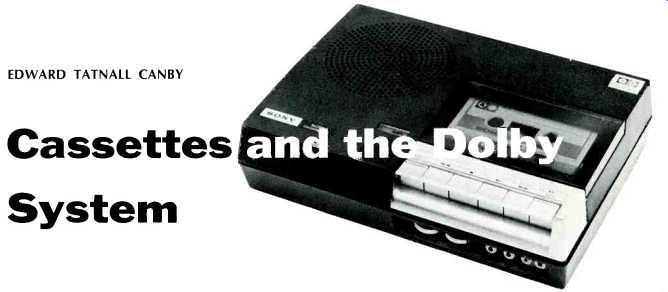
by EDWARD TATNALL CANBY
Among themselves engineers sometimes use a special superlative that says more than all the supers and ultras you will ever hear: state of the art. It is a sober term, and woe to the professional who uses it unwisely and too well. In this early spring of 1970, some of us have just heard the sound of a state-of-the-art cassette. No more was claimed-but the impact of the low-key demonstration was awesome. Here, it would seem, is the beginning of a major turn in consumer or "home" type recordings of all sorts, and one again the durable disk is threatened. The cassette may soon sound better.
This is the more interesting because for its special cassettes Advent (a very busy young company these days) has brought together two major recent developments long since separately hailed in this magazine-the Dolby noise reduction system, in its new "B" ( for home audio equipment ) circuitry, and that fabulous black Dupont Crolyn chromium-dioxide tape which is still officially non-existent in audio but is appearing all over the place sub rosa, short of the actual consumer market.
As we all know, the cassette has made it, after a surprisingly long gestation since Philips introduced it in Europe. It's booming. But present cassette dogma is positive: the system, for all its convenience and compactness, is with its lib-ips speed and tiny, narrow tape strictly not for hi-fi.
Tonal range is punk to so-so. Dynamic range is limited. Distortion and mechanical wow-and-flutter are mostly too high for serious hi fi listening. ( Try a piano! ) Worst of all, juggling of recording parameters results in entirely too much hiss, which is omnipresent and apparently as unavoidable as record scratch in 78-rpm disk days. The cassette, then, is mainly for ultra-convenient speech recording and for not-so-hi-fi music. The audiophile isn't touching it.
Curiously, manufacturers under these circumstances cannot afford to build solid quality into existing cassette players, as they do, for instance, into the better automatic disk players. Serious listeners simply will not pay for it. And thus flimsy equipment leads to more flimsy sound. A vicious circle indeed.
It is this sort of dogma which the Advent people undertook to refute by example. How astonishing to hear them state, matter-of-factly, that the cassette can remove the quality limitations inherent in the state-of-the-art disk recording! The limitations, they say, aren't in the cassette at all. On the contrary, the cassette at last opens up new horizons for technical improvement.
We heard the evidence via a series of A-B tests in which familiar recordings were deftly compared, in conventional disk format, via standard commercial cassettes and in the specially made state-of-the-art cassettes, produced (like disk recordings) from tapes copied from recording-company masters. Time after time, the new cassette sound easily equaled, or even surpassed, the best disk sound in vital respects. Frequency range and low distortion. Dynamic range. Wow and flutter. And, most important, low background noise. Velvet silence! Who has ever heard that from a cassette! These had it.
No one factor was responsible and this was Advent's intent. This was a careful adding-up of many virtues, out of painstaking efforts to improve all aspects of cassette performance within the standard parameters. But Crolyn and Dolby were clearly the big news. At the very slow speed Crolyn gives perhaps a 6-dB advantage in noise over top-quality iron oxide tape and an easily wider tonal range--hence a cleaner, more satisfactory signal.
The Dolby "B" circuit drops the noise level in a different fashion, by 10 or 15 dB without the slightest observable effect on the musical signal. (My ears vouch for that, as they did for the original pro "A" circuitry.) A carefully chosen commercial cassette player, a production model, took care of the wow and flutter. ( Nameless, because not all of its examples are quite as good.) If you can do it once, you can do it again, was my thought.
To answer an inevitable question--how about mass production?--Advent sent out a Dolby-treated tape for commercial processing, onto non-Crolyn BASF tape, via high-speed duplicating equipment exactly as in a standard production cassette. Even so, played back through the Dolby circuit the sound was markedly better than that of the very same recording played normally from a commercial cassette release. And the noise improvement was fantastic. Cassette advancement must be many faceted but even one major element can tip our scales heavily towards a change of thinking.
The disk, to be sure, is not yet dead and won't die so long as its cost, quality, and ease of handling remain important. But the handy little boxes of tape are going to offer formidable competition to all forms of disk, right up to the top, and simultaneously to every kind of home reel-to-reel tape, a system that is already reeling, shall we say, under the impact of increased cassette sales.
So this miniaturized tape, you must now understand, is likely to be the medium for home hi fi some day, give or take a few years. As one good soul put it after the state-of-the-art demonstration, only a single problem still remains hopelessly insoluble. Where do we put the program notes? Not even Dolby can answer that one.
==========
(adapted from Audio magazine, May 1970)
Also see:
High Fidelity from Cassette Systems (Oct. 1973)
Cassette Tape Recording Bias (Nov. 1973)
Dolby B-Type Noise Reduction System (Sept. 1973)
The 8-Track/Cassette Cold War Gets Warmer (Jan. 1970)
= = = =